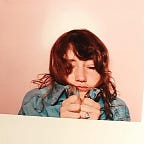A conversation with Color Design Fellow Michelle Strecker
This is the third of a three-part series on the Color Design Fellowship. We’re currently looking for an aspiring product designer and content designer to join our next cohort of fellows.
In 2021, we launched the Color Design Fellowship, a 12-week rotational program aimed at providing candidates with the opportunity, tools, and mentorship to tackle a real-world problem through product design, content design, and research. There are lots of incredible internship programs in our industry for new grads, and we wanted to create space for folks from non-traditional backgrounds to kick-start their professional journey as designers.
We welcomed our first cohort of fellows in September, and their work and willingness to help us kick the tires on our new program far exceeded our expectations. I sat down over Zoom with Michelle Strecker in her final week to talk about her experience as a Color Design Fellow, goals for the future, and to ask for any advice she might have for future cohorts.
What were you doing before you became a designer, and what led you to change careers?
I’ve been interested in design my entire life, I just didn’t know it was called user experience design. As a genetic counselor for 20 years, I really tried to help patients have the best experience they could through some really hard times in their lives. And I’ve always been incredibly interested in reaching populations that are underserved in so many ways, whether it’s healthcare, financial services, or mental health.
What I found really powerful as a genetic counselor was the ability to engage so many of the patients that we served through digital experiences. They didn’t necessarily need to get a genetic counselor on the phone. They felt more comfortable doing it this way and learned just as much, and I saw the power of technology in bridging the gap and helping to democratize care. And I wanted to be a part of it.
What did you work on during your Fellowship?
I had a chance to work on three really interesting projects. One of them is a project called the All of Us Research Program, which is an effort run by the National Institutes of Health, with the goal of studying a million people’s genetics and health. One of the projects that Color is supporting is a platform to allow every laboratory that’s collaborating on the project to agree on the variant interpretation. I worked on early iterations of a dashboard to help the laboratories with this task based on learnings from usability testing.
I also worked with our design systems lead to conduct an audit of error states across our form fields, since the team was in the process of implementing a new design system. That taught me a lot about QA and how to specify the things that engineers need to know in order to make the experience consistent. Finally, I got a chance to work on the user research team in the area of vaccines. We conducted one usability test on the booster registration process, and then I did some exploratory work with folks that are unvaccinated and how they feel about employer vaccine mandates.
Part of your experience as a Fellow was exploring different roles. How did working on different types of projects help shape your thinking around the type of role you’d like to pursue?
I think the most important thing I learned is that every designer I’ve worked with is so supportive, and really interested in helping you grow as a person and as a professional. And so that made it a lot easier to do explorations, because I felt like even if I failed, by my own standards, that there wouldn’t be a judgment against me. And that’s a pretty big deal to me.
And then I met our design technologist and I absolutely fell in love with accessibility. We were in a meeting together, and she was pulling up the browser inspect tool and editing some code while we were talking to illustrate some elements of accessibility. I just love the idea that you can pair this really technical field of understanding code with this very personal and emotional side of design, which is to truly see things from everyone’s perspective. It’s tough to remember that people don’t have the same abilities you do, and you can’t assume that they do. The idea of looking at design fundamentally from a different perspective and thinking about those different abilities, and then making the design inclusive–I just love that. That’s what I want to focus on.
Now that you’ve had this experience, what’s next?
There’s a lot of fields I’m interested in — in addition to health, I like education technology and platforms that help people manage their money. So I think I will try to find something that encourages me and makes me feel proud of the work I’m doing. Eventually, I hope to transition into something healthcare related, because that really is my passion. And I think that’s where I excel.
What advice would you have for others considering this Fellowship?
Do it? No, seriously, though, the fellowship is just a unique opportunity to work with people who are incredibly passionate about what they’re doing, and have a noble, inspiring goal. And I think that’s a really neat and dynamic experience that you probably wouldn’t get anywhere else.
Michelle Strecker is an Oakland-based Product Designer on a mission to create inclusive experiences that help people live better lives.
